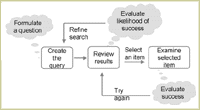|
Readings on Search
Browsing v. Searching
Marcia Bates The
Design of Browsing and Berrypicking Techniques for the Online Search Interface,
1999
Bates offered a new model, "berrypicking" as "closer to
the real behavior of information than the traditional model of information
retrieval." She called this an "evolving search" in which
the user collects "individual references and bits of information
at each stage of the search." This model may also describe a general
information-seeking strategy.
Koyani and Bailey, Searching
vs. Linking on the Web: A Summary of the Research, 2002
Good summary of research to date on how users find information from Usability.gov
Quesenbery, On Beyond Help: User Assistance
and the User Interface Technical Communication, Volume 48, No.2,
p.182-188 May 2001. Published version vailable on Technical
Communication web site, accessible to subscribers
This article looks at the problem of finding information from a user assistance
perspective, but is applicable to a general view.
Shneiderman, et al, Clarifying
Search: A User Interface Framework for Text Searches
A four- phase framework for user-interface design: the framework provides
common structure and terminology for searching while preserving the distinct
features of individual collections and search mechanisms
Jared Spool/UIE
on search and Nielsen
on search
Competing views, not recent, but still cited.
Classification Strategies
Bates, Marcia, After
the Dot-Bomb: Getting Web Information Retrieval Right this Time,
2002
Good overview of classification strategies. The abstract says, "In
the excitement of the "dot-com" rush of the 1990's, many Web
sites were developed that provided information retrieval capabilities
poorly or sub-optimally. Suggestions are made for improvements in the
design of Web information retrieval in seven areas. Classifications, ontologies,
indexing vocabularies, statistical properties of databases (including
the Bradford Distribution), and staff indexing support systems are all
discussed."
Peter Merholz Innovations
in Classification, 2001
Includes a case study of classification and navigation on two wine sites,
demonstrating the effectiveness of the one built on user mental models
and terminology.
Glassel, Aimee, Was
Ranganathan a Yahoo!?, 1998
Interesting overview of the relationship between facet theory and hierarchical
classifications like Yahoo from an internet cataloger. (Shiyali Ranganathan
first developed the concept of facet as a general classification of all
subjects.)
English, Hearst, et al Examining
the Usability of Web Site Search
This paper includes a detailed case study of epicurious.com, a food and
recipes web site that includes a large-scale faceted search (under Browser
Recipes)
UIE, Strategies
for Categorizing Categories
Short, e-commerce focused article from Jared Spool/UIE. The most compelling
conclusion is that the more pages someone with a clear goal in mind has
to visit, the less chance they would buy.
Hagedorn, Information
Architecture Glossary
A glossary of terms
Classifications, Taxonomies and Tools
Dublin Core Meta Data Initiative
"The Dublin Core Metadata Initiative is an open forum engaged in
the development of interoperable online metadata standards that support
a broad range of purposes and business models. DCMI's activities include
consensus-driven working groups, global workshops, conferences, standards
liaison, and educational efforts to promote widespread acceptance of metadata
standards and practices"
American Society
of Indexers Thesauri Online
A master list of various thesauri available online.
FacetMap.com
Good explanation and demo system for a facet navigator. Also includes
open-source code for the product in progress.
Flamenco
Flamenco is a search technology that incorporates (and exposes) faceted
metadata, developed at Berkeley. There is a demo of a document archive
searched with the tool available online
Visual Presentation of Information
Shneiderman, Treemaps
for space-constrained visualization of hierarchies, 1998,2002
The work on Treemaps started as a research project in 1989 on how to present
the files on a large (20 Meg) hard disk. It is most popularly known for
the SmartMoney Market Map.
This page is an entry point to the collection of papers and tools at the
University of Maryland HCIL (Human Computer Interaction Lab)
Shneiderman, Dynamic
queries, starfield displays, and the path to Spotfire 1999
This article is a summary of another long series of explorations in information
visualization. The early work was heavily based on the presentation of
geographic information, but later prototypes also included structured
data such as film databases. The underlying theory is that the query is
constructed through direct manipulation of controls for different fields
in the database.

 This
bibliography accompanied several talks on search and helped me form my
model of search that includes the user "thought
moments" as well as on-screen interaction. It was compiled
in 2002. This
bibliography accompanied several talks on search and helped me form my
model of search that includes the user "thought
moments" as well as on-screen interaction. It was compiled
in 2002.
For further reading, one of the best resources have
found is Search Tools, with
links to industry reports, comparisons of search engines and some good
tutorials.
The URL for this article is: http://www.wqusability.com/articles/search-references.html
Whitney Quesenbery works on user
experience and usability with a passion for clear communication.
She is the co-author of Storytelling for User Experience from Rosenfeld Media. Before she was seduced by a little beige computer, Whitney was
a theatrical lighting designer. The lessons from the theatre stay with her
in creating user experiences. She can be reached at www.WQusability.com |

